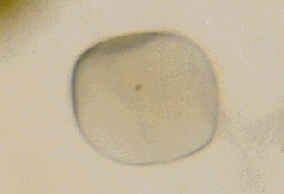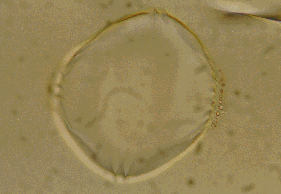

Examination of primary melt inclusions (MI) has long been used to constrain the behavior of volatile elements in the lithosphere and more especially for volcanic systems (subduction zones or hot-spot volcanoes). These tiny droplets of magma, trapped in crystals during their growth, are believed to preserve the composition of the magma at the time of the trapping when they were quenched and preserved as "glassy" inclusions. Therefore, they are considered powerful tools to constrain the initial magmatic volatile content (H2O, CO2...) and the degassing processes of volcanic systems. It has been pointed out theoretically, however, that MI may not be considered as closed systems with respect to water, once they have been trapped in host minerals. In order to address this question, we have investigated the potential water loss from MI trapped in natural magmatic quartz from Guadeloupe Island (Lesser Antilles), placed in a pressure-temperature environment for a duration of a few days. The quartz crystals were double-polished plates with a MI in their centre. The samples were put in platinum capsules and run in TZM rapid quench autoclaves. Before the experiments, a TEM study of the MI-quartz interface showed no fractures or dislocations that could facilitate loss of water from the inclusions. After the run a change in MI morphology was always observed. TEM investigations of the MI-quartz interface after the experiments revealed the presence of partially healed fractures in the host crystal, in association with small bubbles (<0.5 µm) that may be fluid inclusions (Fig. 3.5-6). FTIR spectra of the MI were acquired before and after the runs and revealed a systematic loss in water during the experiments. More investigations and analyses are now in progress. As a preliminary conclusion, we can already deduce in some cases, such as during crystal accumulation in plumbing systems, that natural MI may partially lose their water. This implies that, in the attempt to constrain magma degassing processes, MI have to be cautiously studied from a petrologic perspective first.
 |
 |
Fig. 3.5-6: A melt inclusion (diameter: 50 µm) before (1) and after (2) an experiment. The morphology of the inclusion was modified and tiny droplets developed along partially annealed fractures in the host crystal at the melt inclusion-quartz interface. During the experiment, the water content of this inclusion decreased from 5 wt% to 3.2 wt% (± 0.2 wt%). |
|

Tel: +49-(0) 921 55 3700 / 3766, Fax: +49-(0) 921 55 3769, E-mail: bayerisches.geoinstitut(at)uni-bayreuth.de
 Previous page
Previous page